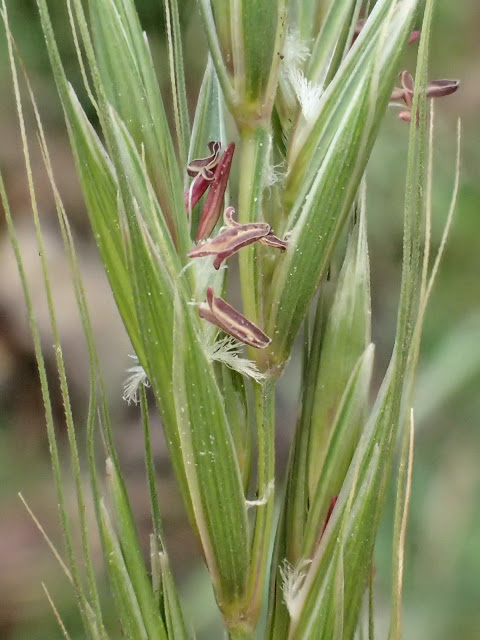Couch, Bearded Couch, Golden Oat-grass, Upright Brome, Cock's-foot
 |
| Couch-grass - November |
These four grasses found in the second week of November are from very different habitats
Couch, - ruderal - garden weed. disturbed roadside
Bearded Couch, Woodland or woodland edge
Golden Oat-grass, Lime-rich meadow or pasture
Upright Brome: Lime-rich place -but an "incomer" always beside a means of communication - e.g. railway or canal
The plants normally flower in June, but these specimens have flowered late.
Couch, - ruderal - garden weed. disturbed roadside
Elytrigia repens
This was at the roadside over the Bridge into Giggleswick near the Swimming Pool and a the path beside the riverside walk
The flowerhead is a spike and the spikelets lie flat against the stem like hands praying. It has rhizomes (underground shoots) and spreads by rhizomes over big areas. Maybe you know it in your garden?
2. Bearded couch - Elymus caninus
Further along the Ribble riverside path under the trees you can find Bearded Couch - It is sort of woodland habitat - But I photographed this plant on the path to Stackhouse next to the bridge at Langcliffe Locks
The flowerhead is similar with spikelets arranged like praying hands - but the glumes have a long awn (bristle) - giving it thebearded appearance.
Look you can see the purple anthers oht their filaments, making pollen and the white feathery stigmas - It IS still in flower.
 |
| It does NOT have auricles - and see below it grows in discrete tufts |
 |
| It grows in tufts. It does not have rhizomes to enable it to spread |
3. Golden Oat-grass - Trisetum flavescens
This is one of the most delicate of our Oat-grasses - Oat-grasses usually have an awn (bristle) with a bend in it coming of the back of the lemma. This usually has three awns per spikelet
 |
| It grows in base rich soils. The leaves are not big, so if the plant is not in flower it is often missed. Here it is growing in a steep limestone pasture just above Stackhouse but sheltered near a wall |
4. Upright Brome: Bromopsis ramosa
I have only ever found this species in Craven in places where it has "come in". i.e. beside the Leeds-Liverpool Canal, and here on a track next to the railway, on the track from the Hoffmann Kiln back to Langcliffe. Whereas it is abundant on the Downs in the south of England. It has long narrow spikelets and the lemmas have straight awns.
Bonus:
5. Cock's-foot - Dactylis glomerata -
I found this in the limestone pasture but it can grow well in neutral pastures and road verges.

EXTRA NOTES FOR 9 NOVEMBER:
In my walk to the hills above Stackhouse and on the track behind my house on 9 November I found the above five gasses in flower plus twenty more species of flower - including Thyme, Heather, Harebell, and Sweet Cicely, (and Field Scabious on the railwayside track). Two new species that I have still yet to show on the blog are Cerastium glomeratum and Fairy Flax Linum catharticum.. but they are for showing another day.
I found about five species of waxcap. My favourite waxcap field was a "Deadloss" in that it was tremendously undergrazed - long tussocky grass - and I only found one species of fungus.
For the record, this is written on 12 November - When we are a week into our second lockdown, when we have recorded 50,000 Covid Deaths in the UK. When Craven is still hovering each week at 190-210 new cases per 100,000 people (Compared to c 2 or 3 per week in July and August





No comments:
Post a Comment